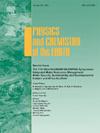Pore structure and radon emission characteristics of shallow soil in the Golmud River Basin of the Qinghai‒Tibet Plateau
IF 3
3区 地球科学
Q2 GEOSCIENCES, MULTIDISCIPLINARY
引用次数: 0
Abstract
The Qinghai-Tibet Plateau (QTP) has a high altitude, strong radiation and wide distribution of frozen soil, with typical alpine soil. Investigating the radon exhalation level of this distinctive soil is crucial for assessing the human settlement environment in the region. This study takes the Golmud River Basin as a case to study the pore structure and radon emission characteristics of shallow soil in a typical QTP area. Furthermore, explored the correlation between terrain, altitude, depth, and pore structure with radon emission rate. The key findings are as follows: In areas with severe salinization, soil exhibit the largest specific surface area and total pore volume, the mean values were 20.07 cm2/g and 0.05 cm3/g, respectively. As altitude increased, the specific surface area, total pore volume, and macropore fractal dimension Da gradually rose, accompanied by significant expansion in macropore diameter. Soil at depths less than 20 cm demonstrated smaller specific surface area, total pore volume, and Da. Conversely, depths exceeding 20 cm exhibited significantly larger specific surface area and total pore volume, albeit with a tendency for these metrics to decrease with increasing depth. Radon exhalation rate generally increased with burial depth and elevation. Notably, soil radon exhalation rate exhibited a positive correlation with micropore content and total pore content, with a stronger correlation observed with total porosity. While the source area displayed higher radon exhalation rates compared to the deposition area, the overall soil radon exhalation rate in the QTP was relatively lower than other global regions, the maximum is only 0.42 × 10−3 Bq/g·h. These research outcomes offer valuable insights for soil radiation risk assessment in the QTP.

青藏高原格尔木河流域浅层土壤孔隙结构及氡排放特征
青藏高原海拔高、辐射强、冻土分布广,具有典型的高寒土。调查这种独特土壤的氡排放水平对于评估该地区的人类居住环境至关重要。本研究以格尔木河流域为例,研究了典型QTP地区浅层土壤孔隙结构和氡发射特征。进一步探讨了地形、海拔、深度、孔隙结构与氡发射率的相关性。结果表明:盐渍化严重地区土壤比表面积和总孔隙体积最大,平均值分别为20.07 cm2/g和0.05 cm3/g;随着海拔高度的升高,比表面积、总孔隙体积、大孔分形维数Da逐渐增大,大孔直径显著增大。深度小于20 cm的土壤比表面积、总孔隙体积和Da较小。相反,深度超过20 cm时,比表面积和总孔隙体积显著增大,但随深度增加,这些指标有减小的趋势。氡呼出率一般随埋深和海拔升高而增加。土壤氡呼出率与微孔含量、总孔含量呈正相关,与总孔隙度相关性更强。源区氡析出率高于沉积区,但总体土壤氡析出率低于全球其他区域,最大值仅为0.42 × 10−3 Bq/g·h。这些研究成果为QTP地区土壤辐射风险评价提供了有价值的见解。
本文章由计算机程序翻译,如有差异,请以英文原文为准。
求助全文
约1分钟内获得全文
求助全文
来源期刊

Physics and Chemistry of the Earth
地学-地球科学综合
CiteScore
5.40
自引率
2.70%
发文量
176
审稿时长
31.6 weeks
期刊介绍:
Physics and Chemistry of the Earth is an international interdisciplinary journal for the rapid publication of collections of refereed communications in separate thematic issues, either stemming from scientific meetings, or, especially compiled for the occasion. There is no restriction on the length of articles published in the journal. Physics and Chemistry of the Earth incorporates the separate Parts A, B and C which existed until the end of 2001.
Please note: the Editors are unable to consider submissions that are not invited or linked to a thematic issue. Please do not submit unsolicited papers.
The journal covers the following subject areas:
-Solid Earth and Geodesy:
(geology, geochemistry, tectonophysics, seismology, volcanology, palaeomagnetism and rock magnetism, electromagnetism and potential fields, marine and environmental geosciences as well as geodesy).
-Hydrology, Oceans and Atmosphere:
(hydrology and water resources research, engineering and management, oceanography and oceanic chemistry, shelf, sea, lake and river sciences, meteorology and atmospheric sciences incl. chemistry as well as climatology and glaciology).
-Solar-Terrestrial and Planetary Science:
(solar, heliospheric and solar-planetary sciences, geology, geophysics and atmospheric sciences of planets, satellites and small bodies as well as cosmochemistry and exobiology).
 求助内容:
求助内容: 应助结果提醒方式:
应助结果提醒方式:


